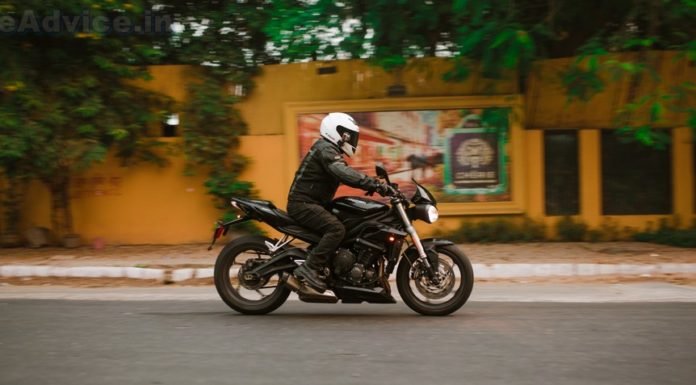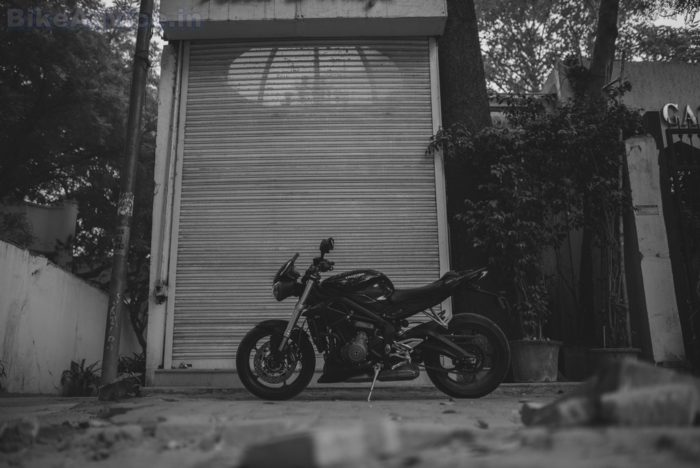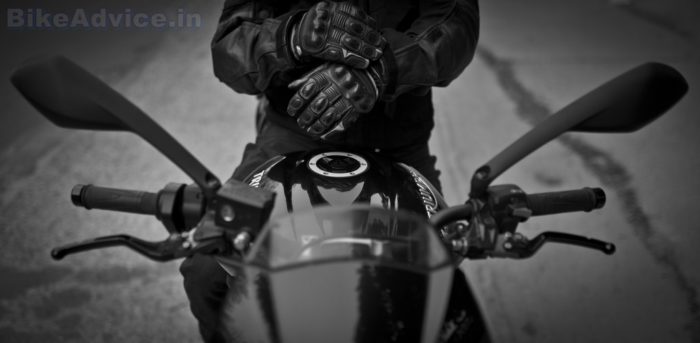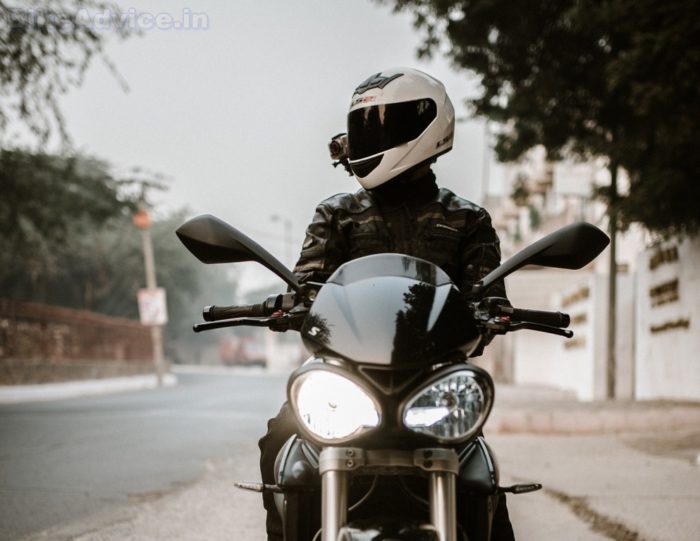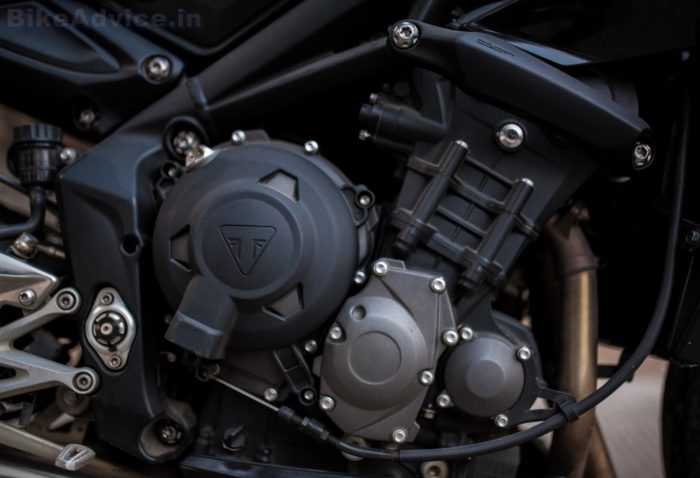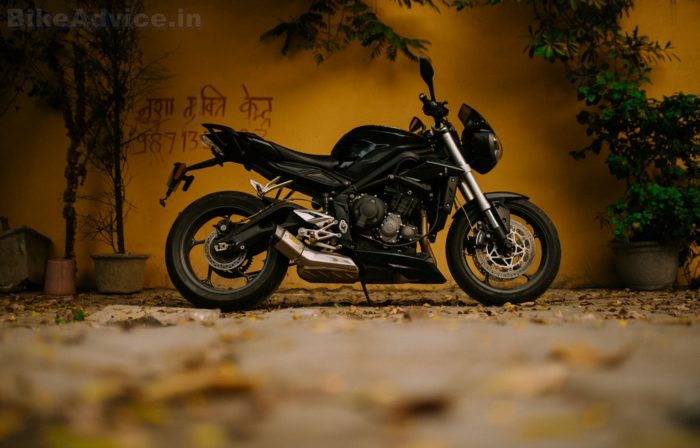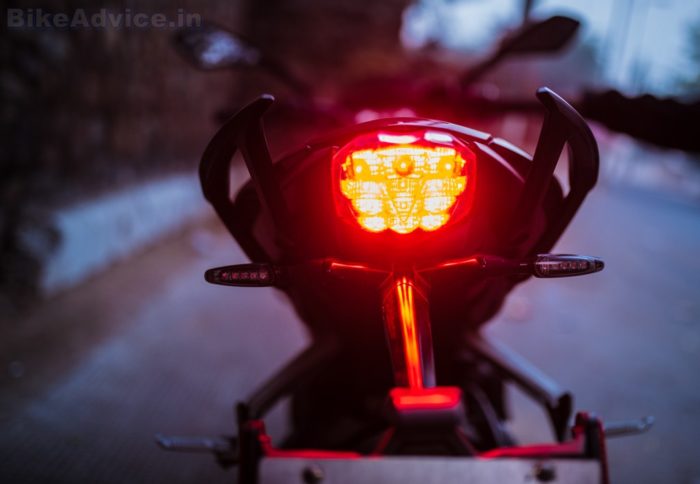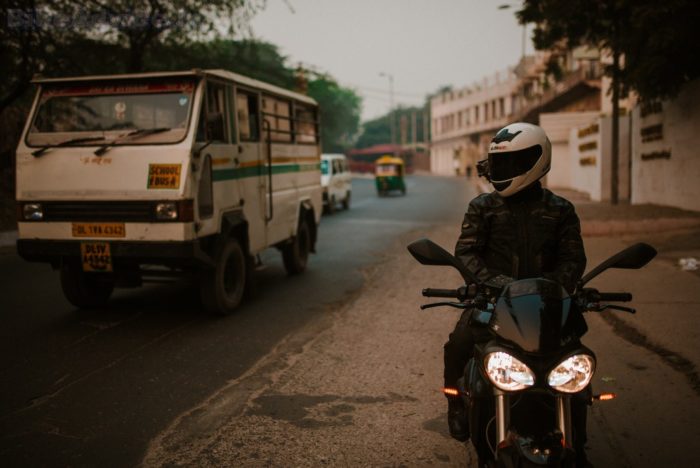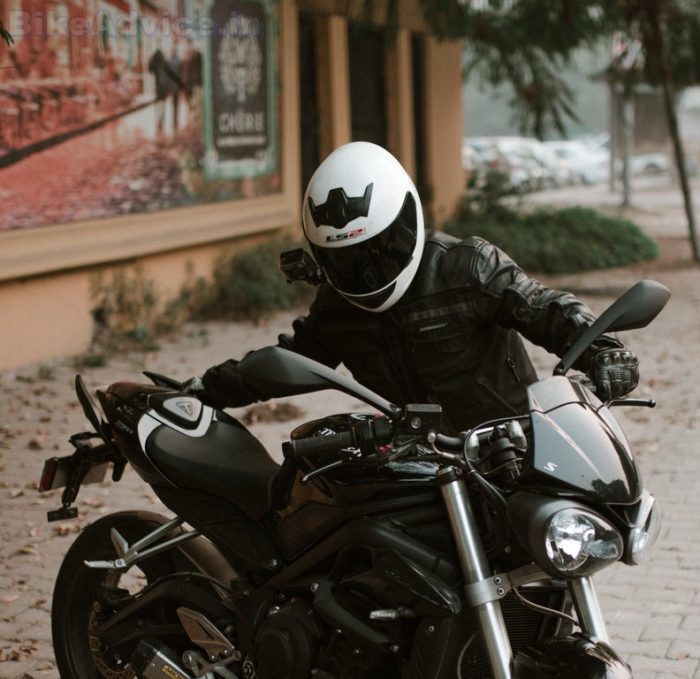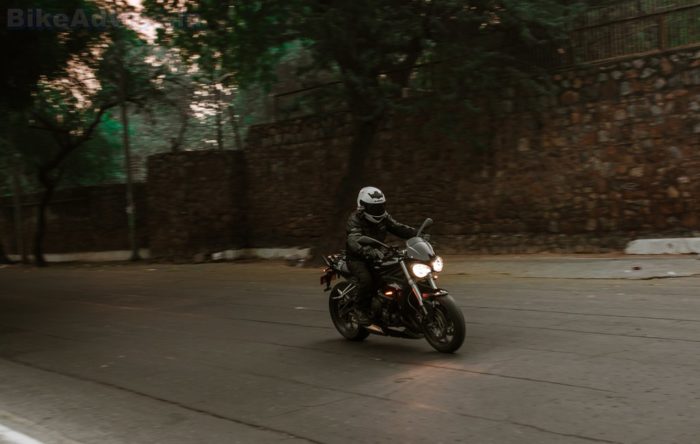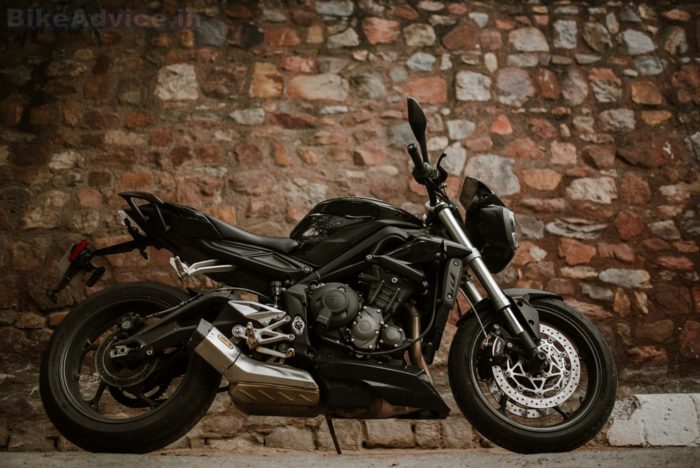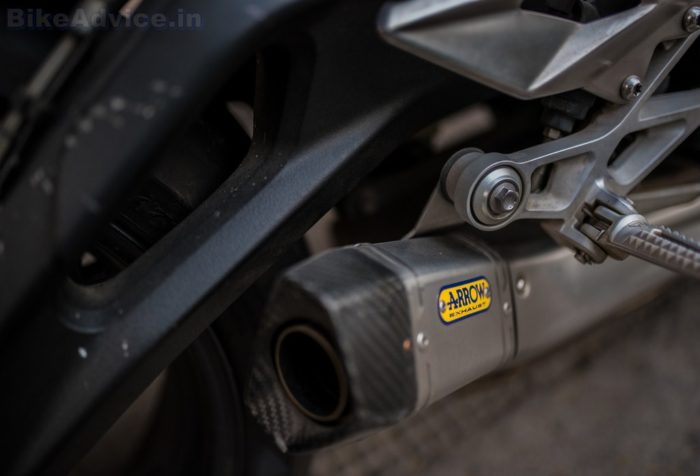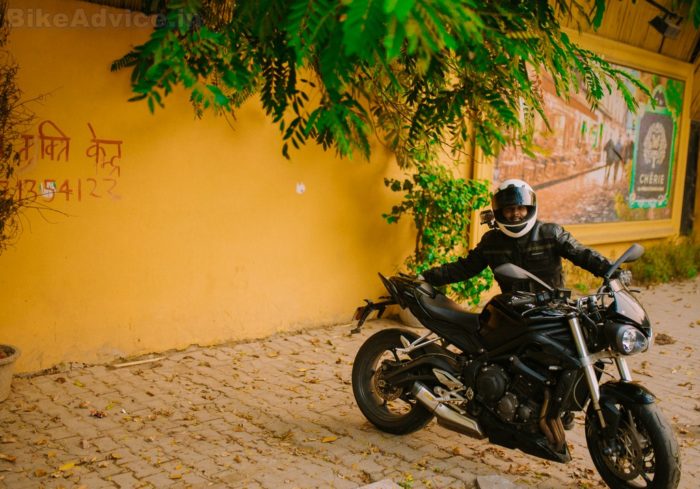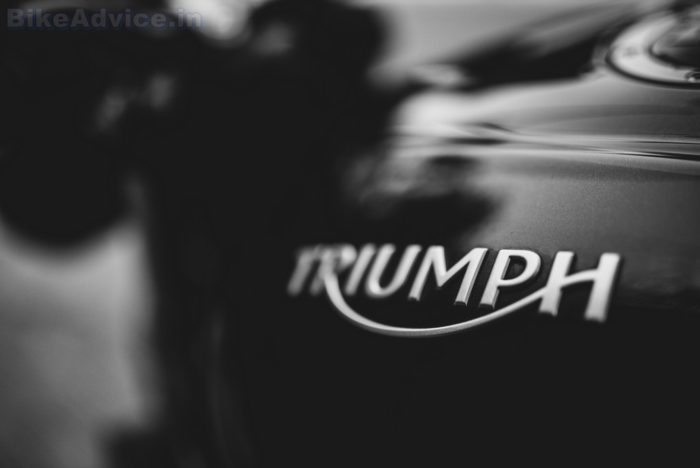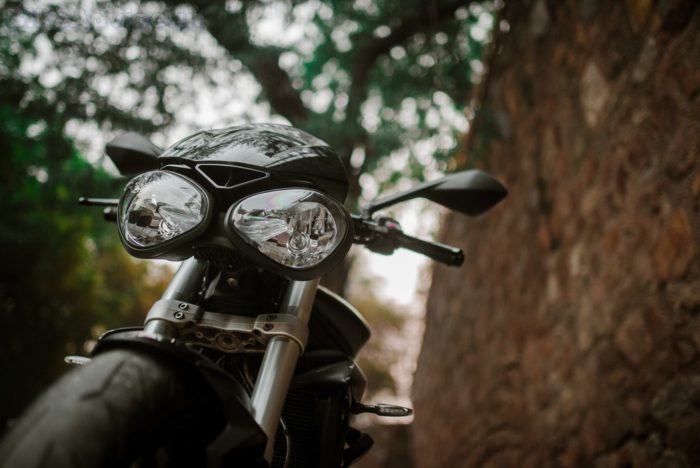2018 Triumph Street Triple S Review:
Words: Syed Shiraz Photography: Himanshu Sharma
The previous Street Triple was a fantastic motorcycle, but there was one BIG problem with it – I didn’t get to review it. Triumph India addressed that this time around though, and gave this, the all-new Street Triple, to me for a good number of days to ride around and review. However, something struck me while I was making an impromptu video review of the motorcycle – I realized that Triumph had not been giving motorcycles to me with a pillion seat lately! First, it was the Street Twin, which did come with a proper saddle that could hold a pair of derrieres, but its Vince & Hines scrambler exhaust (accessory) made it a strict single-seater. And now, the Triple S also was given to me with a load of accessories on it, including a rear cowl in place of the pillion seat.
See, I love riding solo, but that doesn’t really give anyone a right to assume that I don’t have female company, right? In fact, I now recall, a few months ago they were asking me to review the Bobber too! Really Triumph? Next time, I want a pillion seat, and a sidecar. Just in case she wants to get her sister along. Oh, by the way, I really wanted to review the Bobber, and the only reason you don’t see it here is that it was damaged by a Delhi-based female influencer (a student!) who was out on a joyride on Delhi streets with a few of her hooligan friends from South India. Anyway, let’s get on with our Triumph Street Triple S review now, shall we?
TRIUMPH STREET TRIPLE S REVIEW: Design & Ergonomics
I love naked motorcycles. They represent motorcycling in its purest form – raw, devoid of pretense, and absolutely functional. However, their almost organic form makes some of them so bulbous that they remind me of the latest fad of referring to obese female models as plus-size. On the other hand, some nakeds either look malnourished or like a grasshopper on steroids. The Street Triple, thankfully, doesn’t come under any of these categories.
There’s neither an ounce of fat on it, nor is there any ungainly femur staring in your face from anywhere. Look closely and you almost feel as if they used a chisel to give the Street Triple its final design touches! Every part, panel, and surface of this Street Triple exudes sharpness, giving it a piercing demeanour that’s further emphasized by its nose-down-tail-up stance.
But it’s not a motorcycle you’d call pretty. I mean, you would never hear “Oh! That’s a beautiful bike!” while riding a Street Triple. In any colour. So it’s not for posers. It’s another matter altogether that the same posers would get insanely jealous of a guy sharing pictures of his podium finish on a Street Triple. However, all that isn’t important for keen riders; ergonomics are, as this is one aspect that single-handedly decides the number of kilometers you will, or will not, clock on your ‘dream machine’.
So ladies and gents, boys and girls, sit up and listen – the Street Triple S has the best ergonomics of all sportbikes we’ve tested yet! Okay, it’s actually a tie between it and the Suzuki GSX-S1000, but since you can’t buy the latter anymore, the Street Triple gets to take the crown home.
So what all make the ergonomics the best, you ask? The riding posture, primarily. It’s sporty, obviously, but without giving your wrists and forearms any chance to complain even under the worst traffic conditions! The clutch pull is light; the steering lock is generous, and the saddle is perhaps the most comfortable in the segment! The best part is that despite its 810 mm high seat, the Street Triple provides a better reach to the ground than the Monster 797’s 805 mm saddle!
The stock mirrors are absolutely rubbish though. They look beautiful, but come with zilch adjustment. Of course, you can play with the yokes, but that would be working around an issue, which just doesn’t befit a bike of this stature. I need better rear view mirrors, if not a Chronovisor, at this price point, period! That said, I somehow feel it’s deliberate. The chaps at Triumph know that, with the kind of performance on hand, you won’t be checking them much anyway…
TRIUMPH STREET TRIPLE S REVIEW: Performance & Fuel Efficiency
And performance of this Street Triple is something that will make you question the existence of bigger machines in our landscape. Introduced some 11 years ago, the Street Triple had always been using the Daytona’s 675 cc motor. Now, for the first time ever, it gets a bigger 765 cc engine, which makes even this base model more powerful than any Street Triple before it.
And at 166 kg dry, it’s not only the lightest Street Triple yet, but also the lightest motorcycle in the segment! Now I won’t even pretend to lecture you on what the combination of more power and less weight translates to in a motorcycle, which was already a blast to begin with. You’d already know that. In case you don’t, then let me tell you that it makes the bike even more fun, among other things. And so does the Street Triple, which now behaves like a nymphomaniac on flibanserin.
Well, make that a sophisticated nymphomaniac – someone who’s always eager, but doesn’t intimidate you. That’s how the Street Triple S really is! It excites you, but doesn’t overwhelm – despite being more than capable of it!
PERFECT fueling and two ride modes are the traits that make this 111.5 horsepower machine considerate. They aren’t power modes, thankfully, as neither curbs the power output. Therefore, you always have full power at your disposal. It’s just that in the RAIN mode, which is the softer of the two, traction control and ABS are at DEFCON 1, whereas in the ROAD mode they won’t intervene until absolutely necessary. The best part is that the power delivery remains linear, but never boring, in both modes. You can switch the traction control off for wheelies, but discretion is advised.
Check the short clip below if you want to see how she behaves in her most unrestricted state.
If you’re a car guy, and still reading this review, allow me to rub it in a little more – this, the base Street Triple, is quicker to the ton than ANY CAR you can buy in India for less than a crore! Which means that everything—from the mundane Audi TT to the superlative Porsche Boxster—in the sub-crore fast club will be humiliated by this Triumph at the traffic lights. Heck, even my favourite BMW Z4 will meet the same fate. And so will the mighty 1.5-crore-rupee Posrche 911 Carrera or the bonkers 2.15 crore-rupee Jaguar F-Type R! Sorry, car guys; your TSIs and VRSs just won’t cut it here!
A top speed of around 240 km/h is also more than enough than what the richer blokes would ever be able to manage in these cars on our roads. You, dear motorcyclist, shouldn’t be doing that as well; if you can afford this motorcycle, you can afford track days at the BIC too. We can’t, yet, but we still got to tell you what the motorcycle can and cannot do.
There’s one more thing that the Street Triple S can do, other than embarrassing swanky cars. It can merge with traffic smoothly, and inconspicuously, at 40 km/h in sixth gear. You know, just for times when you want to act like a thoughtful egalitarian.
The Street Triple also obliges by not roasting your legs when the going gets even slower amidst all that saintly behavior. Yes, this is one big-capacity multi-cylinder motorcycle you won’t be afraid to handle the rush hour on! Even on less than perfect surfaces as Triumph have done a magical job with the suspension tune of this motorcycle!
The Street Triple S gets a non-adjustable USD Showa Separate Function Fork (SFF) and a preload-adjustable monoshock also by Showa. I won’t talk about the SFF structure and function like how, unlike conventional units, only the left tube houses the spring, while the right takes care of damping, etc., but rather tell you how it feels on the motorcycle. Well, to start with, the ride is unbelievably cosseting – but it never feels squishy at any point in time! Therefore, the handling stays true to whatever adjectives you’ve been hearing about the Street Triple’s handling for years – quick, predictable, and sure-footed.
Here, I must mention that the steering isn’t lightning quick like in the Monster 797, but it’s not slow by any stretch of imagination. In real time, the difference between both the motorcycles following your command to change directions might just be a half millisecond, but it’s there.
But it takes less effort to throw the Street Triple around, thanks to the aforementioned zero flab on this motorcycle. Therefore, the overall time taken in directional changes, say, like in S-bends, would be lesser on the Triumph. It handles like a 250 naked; in fact, it handles a lot better than most of them!
High-speed stability, as you can see in the video above, is brilliant, and so is the tyre grip, but I so wish Triumph had given the Triple R’s M4.32 Brembos to the S as well. The Nissin 2-piston calipers do the job, but I found them to be a tad, I dare say, underwhelming. They kept me alive though, so I may just be nitpicking here.
But I can’t say the same about its ground clearance. So until our politicians, RWAs, and municipal corporations can get their act straight (read: “never”) you’ll do yourself a favour by keeping an eye for those unmarked speed humps and stuff. And when you do see them, don’t be afraid to slow down to almost zero km/h, as the sweet fueling helps you in not stalling the bike while you try to save those beautiful header pipes from getting scraped.
That also reminds me to tell you that my motorcycle came with an Arrow music system.
Yes, it’s a music system, and not an exhaust can. In fact, if it were a human being it would appear in the annals alongside Shakur, Jackson, Sinatra, and Morrison. The Arrow has healing properties. It can mend broken hearts. I forgive you, Triumph, for the solo seat, then.
Broken heart or not, the Street Triple’s 17.4 L fuel tank would encourage you to tour more often. I couldn’t take it outside the city, and it still gave me 16.6 km/l, despite redlining it at every opportunity. Expect a tank range of over 300 km with the low fuel light coming on at around 250 km.
The absence of vibrations up to 150-160 km/h also helps. In fact, even post that mark, there are no vibrations felt at the handlebar, and even the faint presence in the pegs won’t disqualify the Street Triple from being declared as a bike with zero-vibrations.
TRIUMPH STREET TRIPLE S REVIEW: Verdict
While you should have arrived at your own verdict by now, I’ll conclude by touching upon something that doesn’t really fall under any of the sub-heads above, but is still one of the most important aspects of a sportbike for me. I call it the “scare quotient” of a motorcycle. RD350 fans would understand that. If you’re not one yet, let me break it down for you. I am referring to the bike’s ability to scare you sometimes. ‘Sometimes’ being the keyword here, and not every time that a liter-class flagship ensures in its full-power mode (it’s called the F mode for a reason). And you’re a loser if you ride your 200 horsepower missile in L mode (you know now what L stands for, right?). You may as well park it in your living room, then.
But does that mean you don’t listen to your heart at all and end up buying something as uninspiring like a Kawasaki Ninja 650? Absolutely not!
You may consider the fantastically priced Kawasaki Z900, but since it doesn’t come with any ride modes or traction control, it might spell disaster for riders who have not grown up on two-strokes. Or you may check the Street Triple. Its ride modes, while keeping the less-experienced lot relatively safer, provide the experienced riders with unprecedented access to also safely unlock the full potential of the motorcycle. And if you’re someone like me who wants the bike to scare him occasionally, switch the traction control off – it would be more than worth the INR 8.71 lakh (ex-showroom, PAN India) asking price, I assure you.
Next Read: Do Influencers Really Influence Motorcyclists? Part I


